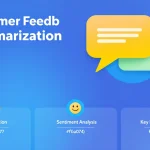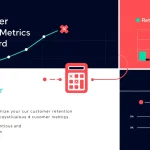Customer Feedback Analysis Tool
Is this tool helpful?
How to Use the Customer Feedback Analysis Tool Effectively
You can quickly analyze customer feedback by following these simple steps:
-
Enter Feedback Text: Type or paste your customer comments into the main text box. For example:
- “I loved the prompt support, but the product quality could improve.”
- “The website navigation is confusing and sometimes slow.”
-
Select Analysis Type: Choose one of the following options:
- Sentiment Analysis – measures the emotional tone of the feedback
- Keyword Analysis – identifies important topics and themes
- Both Analyses – performs sentiment and keyword extraction together
- Choose Language: Pick the language of your feedback from English, Spanish, French, or German. If left unspecified, the tool defaults to English.
- Privacy Settings: Decide whether to remove personally identifiable information (PII) to protect customer privacy during analysis.
What is the Customer Feedback Analysis Tool?
This tool helps you turn unstructured customer comments into clear, actionable insights. It uses natural language processing algorithms to measure sentiment and extract key topics from your feedback, making it easier to spot trends and areas for improvement.
Key Benefits of Using the Tool
- Save Time: Analyze hundreds of feedback entries in seconds instead of manually reading each comment.
- Consistent Results: Apply the same analysis standards across your entire feedback set for reliable comparisons.
- Multi-language Support: Work with customer feedback in multiple languages, enhancing global reach.
- Privacy Protection: Optional removal of personal information helps you stay compliant with data privacy regulations.
- Clear Insights: Convert qualitative feedback into quantitative scores and keyword themes that inform decisions.
How the Feedback Analysis Works
The tool applies two major types of analysis to your customer feedback text:
1. Sentiment Analysis
This analysis calculates an overall sentiment score that reflects the emotional tone of the feedback, using a weighted formula:
$$ \text{Sentiment Score} = \frac{\sum_{i=1}^{n} w_i \times s_i}{\sum_{i=1}^{n} |w_i|} $$- wi = word weight, representing the importance of each term
- si = sentiment value assigned to each word
- n = total number of relevant words analyzed
Sentiment Detection Algorithm
The tool uses the VADER (Valence Aware Dictionary and sEntiment Reasoner) algorithm to provide a compound sentiment score calculated as:
$$ \text{Compound Score} = \frac{\text{Positive} – \text{Negative}}{\sqrt{\text{Positive} + \text{Negative} + 0.001}} $$This score helps identify whether the overall customer feedback is positive, neutral, or negative.
2. Keyword Analysis
The tool extracts key themes by calculating the importance of words using the TF-IDF (Term Frequency-Inverse Document Frequency) method:
$$ \text{TF-IDF}(t,d,D) = \text{TF}(t,d) \times \log\left(\frac{N}{df_t + 1}\right) $$- t = term or keyword
- d = specific document or feedback entry
- D = set of all documents (feedback entries)
- N = total number of documents in the collection
- dft = number of documents containing term t
Topic Modeling Techniques
The tool also applies Latent Dirichlet Allocation (LDA) to group keywords into meaningful topics:
$$ P(\theta, z, w|\alpha, \beta) = P(\theta|\alpha) \prod_{n=1}^N P(z_n|\theta)P(w_n|z_n, \beta) $$This enhances the insight into customer concerns by uncovering underlying themes within large sets of feedback.
Practical Uses of the Customer Feedback Analysis Tool
Example 1: Online Retail Product Reviews
Input feedback: “Packaging was excellent, but delivery was delayed. The staff was responsive and resolved the issue quickly.”
- Sentiment: Mostly positive (compound score 0.58)
- Key Themes: Packaging (+), Delivery (-), Customer service (+)
- Suggested Actions: Improve delivery tracking and scheduling
Example 2: Hospitality Customer Feedback
Input feedback: “The hotel rooms were clean and spacious. However, the Wi-Fi connection was unreliable at times.”
- Sentiment: Positive overall (compound score 0.62)
- Key Themes: Cleanliness (+), Room size (+), Wi-Fi service (-)
- Suggested Actions: Upgrade internet infrastructure
Frequently Asked Questions About Customer Feedback Analysis
Can I analyze several feedback entries at once?
Yes, you can analyze multiple entries by separating each with a line break or by uploading a CSV file with all feedback.
How is the language of the feedback detected?
The tool automatically detects the language using advanced algorithms but allows you to manually select the language for better accuracy.
What insights will I get from the analysis?
You receive sentiment scores, identified keywords and topics, and practical recommendations to improve your products and services.
Can I export or save the analysis results?
You can copy the results to your clipboard or save them for reporting and further review.
How do I integrate this tool with my existing feedback system?
The tool supports various input formats and can connect with most feedback platforms via APIs for streamlined analysis.
What makes this tool different from basic sentiment analyzers?
It combines sentiment scoring, keyword extraction, and topic modeling to provide a deeper understanding of customer opinions.
Tips for Maximizing Your Feedback Analysis
Best Practices
- Analyze feedback consistently to monitor trends
- Compare results across different periods to identify changes
- Use insights to guide product or service improvements
- Combine quantitative data with customer quotes for richer context
- Share findings with your team to align strategies
Implementation Suggestions
- Start by analyzing small batches of feedback to understand patterns
- Maintain consistent categories for better analysis over time
- Include feedback from various channels for comprehensive insights
- Regularly track sentiment trends to detect shifts in customer satisfaction
- Create action plans based on recurring keywords and themes
Important Disclaimer
The calculations, results, and content provided by our tools are not guaranteed to be accurate, complete, or reliable. Users are responsible for verifying and interpreting the results. Our content and tools may contain errors, biases, or inconsistencies. Do not enter personal data, sensitive information, or personally identifiable information in our web forms or tools. Such data entry violates our terms of service and may result in unauthorized disclosure to third parties. We reserve the right to save inputs and outputs from our tools for the purposes of error debugging, bias identification, and performance improvement. External companies providing AI models used in our tools may also save and process data in accordance with their own policies. By using our tools, you consent to this data collection and processing. We reserve the right to limit the usage of our tools based on current usability factors.







